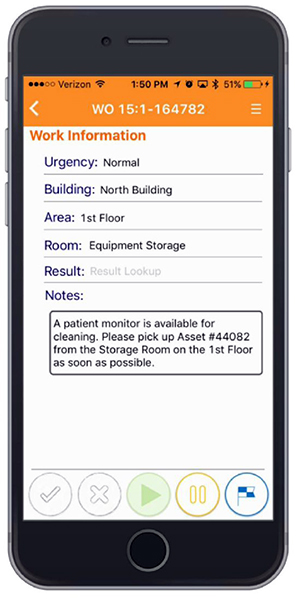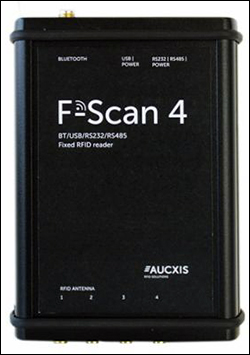Jun 30, 2016The following are news announcements made during the past week by the following organizations:
Hangzhou Century Link;
Impinj, Accruent Healthcare;
Dolphin RFID, Aman Aviation;
Maria&Donato, Thinfilm; and
Aucxis.
Century Link Unveils New UHF RFID Laundry Tags
RFID solutions provider Hangzhou Century Link has added two new passive ultrahigh-frequency (UHF) RFID laundry tags to its CiLink series. According to the company, the TexSilicon (CE36082) and TexSilicon Slim (CE36083) are designed to be used for tracking bed linens, towels, uniforms or other bulk laundry items, in order to improve inventory management, reduce labor costs and optimize the lifecycle of textiles and garments.
The TexSilicon measure 67 millimeters by 30 millimeters by 2.6 millimeters (2.6 inches by 1.2 inches by 0.1 inch), while the TexSilicon Slim measures 80 millimeters by 11 millimeters by 2.6 millimeters (3.1 inches by 0.4 inch by 0.1 inch). Housed in fabric with silica gel, the soft, flexible and thin tags can be applied by various methods, the company reports, such as insertion into a hem, sewing or heat-sealing. Designed to endure the rigors of high-pressure wash cycles, the tags have an IP68 rating, indicating protection from water and chemicals common to commercial laundry and dry-cleaning processes, and are designed to withstand sterilizing heat and pressure. Personalized printing is available.
The TexSilicon and TexSilicon Slim are made with an Impinj Monza 4QT chip supporting the ISO 18000-6C and EPC Gen 2 specifications. The tags offer a read range of up to 3 meters (9.8 feet) using a fixed reader, the company says, and up to 1.5 meters (4.9 feet) with a handheld reader.
Impinj, Accruent Healthcare Partner on Solution for Tracking Medical Devices
Impinj and Accruent Healthcare Solutions have partnered on a new solution designed to automate the management, distribution, availability and maintenance of mobile medical equipment used for patient care.
Equipment tagged with passive ultrahigh-frequency (UHF) EPC Gen 2 RFID inlays made with Impinj chips can be tracked by Impinj readers as it moves around key areas of the hospital. When a reader captures a tag's ID number, it notifies the Accruent system with the equipment's location and service history. Using an online web portal and a smartphone app that are part of Accruent's system, clinical personnel can request and locate equipment, as well as monitor service progress in real time, thereby enabling workflow automation. For example, the companies explain, cleaning requests are issued when soiled equipment is detected. When the equipment is ready for use, the smartphone app notifies employees to return it to circulation. In addition, rooms are monitored in order to ensure that equipment is available as needed.
Since hospital personnel know where and when equipment is available, Impinj and Accruent report, they work more efficiently. Device utilization can be accurately tracked with the data collected for demand orders, refill requests and soiled pickup requests. These utilization reports, the companies note, provide hospital leadership with greater visibility into costs so that they can better plan equipment purchases.
Dolphin Works With Aman Aviation to Boost Airline RFID Adoption in India
Dolphin RFID, an end-to-end RFID solutions company based in India, and Aman Aviation, an Indian maintenance and repair organization (MRO) focused on aircraft components, have announced a partnership to drive adoption of RFID-based best practices in the Indian civil aviation sector. The two companies say they are promoting practices followed by such companies as Boeing and Airbus, and in the process will help airlines to reduce the amount of time airplanes spend on the ground, augment the number of trips, make air travel in India more cost-effective and profitable, and maintain high levels of safety.
Through the collaboration, Aman Aviation will leverage Dolphin RFID's technology to offer solutions for tracing and inspecting airplane equipment that needs to be checked prior to every takeoff, such as oxygen cylinders, first-aid kits, physician's kits, oxygen masks, fire extinguishers, lavatory items, life vests and seat belts. RFID can help to reduce inspection and maintenance times, the two companies report, without compromising the stringent aviation sector safety standards. In addition, they say, RFID solutions can support the efficient tracking of assets and inventory through all stages of a complex supply chain, from manufacturers to bonded stores and on to end users, followed by accurate cloud-based maintenance management for the aircrafts.
Using Dolphin's RFID technology, Aman Aviation can help the ground maintenance staff to track and trace the special tools required for maintenance.
Dolphin's solutions are based on the use of its copyrighted Java-based middleware, known as Edge Wizard. In the commercial aviation sector, the firm explains, most parts required for inventory are supplied with RFID tags. In the Indian aviation sector (as well as in most countries), these tags are not being read to achieve better inventory efficiencies. Dolphin will provide readers from Zebra Technologies, ATID and Hanmi. The first order utilizes Hanmi readers with Dolphin's patent-applied solution working on an Android smartphone. For solutions such as maintenance management, Near Field Communication (NFC) tags will be used, for the most part. For solutions for tool tracking, Dolphin will employ Xerafy and Omni-ID tags.
Aman Aviation plans to use the first of the solutions for its own MRO activities. The company and Dolphin expect to make their RFID-enabled solutions available to Indian airlines sometime during the third quarter of this year.
The Indian aviation sector is on the verge of an exponential expansion that will require an expanded workforce, Dolphin RFID claims, citing a recent research report from KPMG and FICCI that estimates India will be the third largest aviation market by 2020. Per the new civil aviation policy recently cleared by India's government, airlines with a fleet of 20 flights are eligible to introduce overseas flights. RFID solutions will enable airlines to turn around faster by seamlessly managing assets and inventory, having necessary safety checks performed within few seconds and ensuring the highest level of security.
The new civil aviation policy has relieved MROs from having to pay royalties to the airports in which they operate, Aman Aviation reports, which may translate into savings of about 20 percent of operating costs. The money saved can be used to implement technologies, such as RFID, to enable cost-effective, safer and on-schedule air travel for Indian customers.
Maria&Donato to Embed Thinfilm NFC Tags into its Luxury Handbags
Maria&Donato, a craftsman leather-goods manufacturer, is integrating Thin Film Electronics (Thinfilm) Near Field Communication (NFC) RFID tags into its handbag collections to battle counterfeiting and address growing fraud concerns within the broader luxury goods market. Thinfilm's NFC SpeedTap tags, which can be read by smartphones, will also enable consumers to learn more about the brand and the product, the two companies report, and purchase limited-edition handbags online.
Thinfilm's SpeedTap tags are part of the company's OpenSense product line—thin, flexible labels that can both detect a product's "factory sealed" and "opened" states and wirelessly communicate contextual content with the tap of an NFC-enabled smartphone. The NFC chip used in the SpeedTap tag is manufactured using a printing process. The tag's antenna is not currently printed, but Thinfilm says it will begin fully printing the product once it gets its roll-to-roll manufacturing line up and running.
The tags were initially designed for use on bottles, to authenticate a bottle's contents or to indicate (when the tag is read) if its seal has been broken (see Thinfilm Launches OpenSense Printed NFC Sensor Label for Bottles). The SpeedTap tags support 13.56 MHz high-frequency (HF) operation for compatibility with fixed and mobile NFC RFID readers (from smartphones to industrial readers), have 128 bits of read-only memory (roadmap to 256 bits) and adhere to a subset of the ISO 14443 Type A RFID standard. The tags support popular data structures, such as 96-bit GS1 EPC, are less than 300 μm thick, and can be integrated with a product's packaging or label.
"We consider each of our Maria&Donato handbags to be works of art and, in that regard, product authentication is an important part of the customer experience," says Javier Villaverde, Maria&Donato's product development director. "Thinfilm's SpeedTap technology is a highly secure solution that improves our actual anti-counterfeiting system, and gives our loyal customers the assurance and satisfaction they expect when purchasing one of our unique handbags."
Distributors will be able to place orders for bags with Thinfilm's solution starting on July 24, 2016, when Maria&Donato officially launches its RFID-tagged products at the Pure London show, Villaverde says. Customers will be able to reserve the RFID-tagged bags online during the coming days.
Aucxis Launches New Fixed RFID Reader
Belgium-based Aucxis has launched a new fixed ultrahigh-frequency (UHF) RFID reader designed for production environments, automated warehouses and supply chains. The F-Scan 4 reader, the company reports, was developed as an easy-to-integrate, inexpensive fixed RFID reader. It supports the EPC Gen 2 and ISO 18000-6C protocols, and comes with four antenna connections and micro USB, Bluetooth, and RS232/RS485 interfaces. The read range is adjustable from 0 to 10 meters (0 to 33 feet), depending on the antenna used.
The reader measures 120 millimeters by 85 millimeters by 35 millimeters (4.7 inches by 3.3 inches by 1.4 inches) in size, weighs 230 grams (8.1 ounces) and has a black aluminum alloy enclosure that can be mounted with brackets (included). Three LED indicators provide user feedback. Options include custom housing, retuning for special applications, custom firmware and an antenna.



